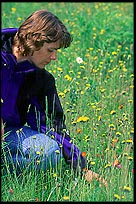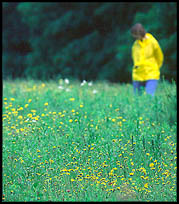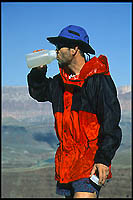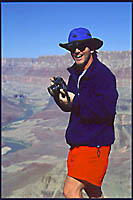 |
|

 |
| |
RAIN GEAR FOR PHOTOGRAPHERS:
A Guided Tour Through the Rain(Gear) Forest
by Rob
Kleine
(A version of this article was first published
as "A Guided Tour Through the Rain (Gear) Forest,"
in Outdoor & Nature Photography, Fall 1997, Peter K.
Burian, Editor)
|
|
 |
 It
is no secret that the most dramatic photo opportunities
occur during periods of changing weather. Most often this
means that a storm is approaching or clearing. Storms mean
precipitation. Whether a sprinkle or a deluge, proper rain
gear can mean the difference between getting that unique
shot, or having to pack up early and head back to the car.
For some practical pointers on selecting rain gear, read
on. It
is no secret that the most dramatic photo opportunities
occur during periods of changing weather. Most often this
means that a storm is approaching or clearing. Storms mean
precipitation. Whether a sprinkle or a deluge, proper rain
gear can mean the difference between getting that unique
shot, or having to pack up early and head back to the car.
For some practical pointers on selecting rain gear, read
on.
The High Tech Approach. Outdoor
photographers of Ansel Adams' vintage had two choices: rain
gear made of oil skins (fabric saturated with oil to make
it waterproof), or waxed cotton. Both fabrics require regular
maintenance to remain waterproof. They are bulky, uncomfortable
in warm weather, and smelly. The advent of fabrics like
PVC and Nylon, and waterproof fabric coatings like polyurethane,
made possible light, compact, and low-maintenance waterproof
rain gear. The revolution continues. Today's outdoor photographer
can choose from a dizzying array of high-performance two-piece
rain suits.
Want Waterproof (WP) or Waterproof/Breathable
(WP/B)? With today's high-performance fabrics you can take
your pick.
WP rain gear is completely waterproof
and fairly inexpensive. PVC, from which ‘el cheapo'
$5 rain suits are made, and urethane coated nylon are examples
of WP fabrics. The downside of waterproof rain gear is that
it can become a mobile sauna. The sweat you generate hiking
with a full photo pack can't escape. Instead, it condenses
inside the jacket soaking you and your clothing. The rain
won't get you, but your own sweat will.
Waterproof/Breathable fabrics have a micro-porous
membrane that is waterproof yet allows sweat vapor to escape
(it breathes). This means you are less likely to get soaked
by your own sweat. WP/B rain gear is also useful as general
purpose windy weather gear. Gore-Tex is the best known brand
of WP/B fabric. Other brands include Campmor's Camp-Tech,
Entrant, Lowe alpine's Triple-Point Ceramic, Red Ledge's
TH4, Solstice's Microshed, and Ultrex.
How do the WP/B fabrics compare? Imagine
a continuum anchored at one end by non-breathable/waterproof
fabrics like PVC. At the other end we have completely breathable
but not waterproof materials like mosquito netting. Each
WP/B fabric falls between these extremes, balancing the
tradeoff between breathability and waterproofness. Some
coatings, Entrant for example, are more waterproof than
breathable. W. L. Gore's new Activent fabric, on the other
hand, emphasizes breathability over waterproofness. Gore-Tex
falls in between.
Fabric construction -- whether 2-ply or
3-ply (see Glossary) -- also influences WP/B fabric breathability.
3-ply WP/B fabrics breathe better and are more durable than
2-ply fabrics. Which WP/B fabric is best? That depends on
how you plan to use your gear. Read the hang tag, ask your
retailer, or call the manufacturer to find out how a particular
fabric performs.
Many photographers believe WP/B fabrics
defy the laws of thermodynamics and breathe constantly so
that interior condensation never occurs. Wrong. Think of
WP/B fabrics as waterproof or breathable, but not necessarily
at the same time. WP/B fabrics breathe best on clear days
when exterior humidity is low. At high humidity levels,
less sweat passes through the porous membrane. When exterior
humidity reaches 100% (it is raining), WP/B fabrics will
keep you dry from the rain but no longer breathe.
|
|
| |
 Buying
Tips. Performance is in the details. Construction details
and features are as important as the fabric for keeping
you dry and comfortable. When examining raingear, consider
the following: Buying
Tips. Performance is in the details. Construction details
and features are as important as the fabric for keeping
you dry and comfortable. When examining raingear, consider
the following:
- Are all seams taped or sealed? Leaky
seams allow seepage that will soak you in a downpour.
- Do generous weather flaps cover all
zippers and snap openings and pockets? Inexpensive rain
suits sometimes cut corners by limiting weather flaps.
- Is construction robust? Is the stitching
straight and well detailed? Will the fabric withstand
how you intend to use the gear? Are the snaps, zippers,
and cord locks of high quality? Are high abrasion areas
reinforced? Does the manufacturer stand behind their product
with a confidence-inspiring warranty?
- Compare styles. Parkas are often long
enough to cover your seat, and full of features like a
hood and multiple pockets. A parka's extra length is much
appreciated when not wearing rain pants. Jackets are often
shorter, have fewer features, and may not have a hood.
If considering a jacket, make sure it has adequate overlap
with the rain pants.
- Does the jacket have an adjustable,
visored hood? Are draw cord ends secured so they won't
batter your face in high winds? If you don't like hoods,
consider a wide-brimmed hat like OR's Seattle Sombrero
Gore-Tex rain hat.
- Does the jacket have a draw cord at
the bottom hem and/or at the waist to seal out weather
or seal in warmth?
- How well does the suit ventilate? Does
the jacket have torso-venting mesh pockets or underarm
zippers (pit zips)? Can you adjust the cuffs -- via Velcro
(TM) or snaps -- to close out the weather or increase
ventilation? (See Tips for Staying Dry Sidebar.)
- Look for chest level pockets that are accessible when
wearing your photopack.
- Buy an oversized jacket that will fit
over layers of bulky insulation and your camera.
- Can you pull the rain pants over the
biggest boots you own? Is the waist belt secure so it
won't slide down under your photopack? Turn pull-on rain
pants inside-out while removing them so boot muck doesn't
contaminate the clean inside.
- Handy are jackets and pants that self-store
in their own pockets to form go-anywhere bundles that
fit in a pocket or a camera bag.
|
|
| |
 Define
Your Needs. So, will a $5 vinyl rain suit suffice or
will a full-featured $500 techno-marvel WP/B rain suit better
suit your needs? It depends: Define
Your Needs. So, will a $5 vinyl rain suit suffice or
will a full-featured $500 techno-marvel WP/B rain suit better
suit your needs? It depends:
- Do you need ruggedness or is light
weight and minimum bulk important to you? A $5 rainsuit
of PVC is light and compact, but will shred quickly if
you hike through a cluster of wild roses. A commercial
grade rain suit made of PVC coated cotton will survive
the roses, and is excellent for extended wet weather photography,
but is heavy and bulky.
- If you walk only a short distance from
car to your subject, or if minimum weight and bulk matter,
consider WP raingear of coated nylon. These compact suits
will fit in a stray corner of your photo pack and are
easy on the wallet. Look for good ventilation features
to manage the inevitable condensation.
- If you often hike or bike to your subject,
and you desire versatility from the gear in your photopack,
consider one of the excellent rain suits made of a WP/B
fabric. I find lightweight WP/B raingear with pit-zips
most versatile. Don't buy an expedition grade WP/B outfit
unless you have an expedition planned.
|
|
| |
Tips for Staying Dry. Despite all my high-tech raingear,
I've never stayed 'bone dry' when photographing in the rain.
The challenge is to minimize how wet I become. Here's what
I do:
- Deploy raingear the moment it starts
raining. It is tempting to say, "I'm almost there,
I'll hold-off." Resist the temptation. Keep your
clothing dry. Wet clothing increases your risk of hypothermia.
- Wear quick-drying clothing under my
raingear. Clothing under the best raingear will become
damp from sweat or leakage. Shirts and pants made of Supplex,
a brushed nylon that resembles cotton, are comfortable
and dry amazingly fast, even in the dampest conditions.
- Anticipate changes in activity level.
If I am stationary, and temperatures are moderate to cool,
interior moisture from sweat doesn't pose a problem. But
my body heats up when I start hiking that ridge in search
of a better vantage point. Even with WP/B raingear, my
sweat quickly begins to condense inside the rainshell
and soak my inner layers. Here's what to do:
- Remove insulation layers worn under
the shell before you begin to hike so you don't overheat.
Insulation stays dry and you stay comfortable.
- Ventilate before you overheat. Open
the shell's front zipper, pit-zips, or vented pockets
to let heat escape before it builds up.
- Get out of the rain. A tarp provides
quick and convenient shelter if you are photographing
in one location for an extended time. I prefer a lightweight
urethane-coated rip-stop nylon tarp with a catenary cut
that facilitates a taught pitch. Ponchos made of coated
nylon often feature loops so they can be pitched as a
tarp.
|
|
| |
Parting Words. Photography in the rain can yield exciting
dynamic pictures. But concentration on your photography is
possible only if you are comfortable. Inadequate raingear
can force you to quit shooting before you had planned, failed
raingear will increase your risk of hypothermia. Choose raingear
with comfort, safety, and intended applications in mind. Don't
skimp. When it is 45 degrees, and you hardly notice the pouring
rain, you'll know you made an excellent choice.
|
|
| |
Glossary of Fabrics
 Understanding
today's high-tech raingear requires negotiating a world
over saturated with techno-jargon. Here's a brief primer
on raingear techno-speak: Understanding
today's high-tech raingear requires negotiating a world
over saturated with techno-jargon. Here's a brief primer
on raingear techno-speak:
- 2-ply construction. The waterproof/breathable
(WP/B) coating is affixed to the back of the outer fabric
(outer fabric + coating = 2-layers). Because the WP/B
coating is exposed, a loose protective liner is added
to protect the WP/B layer. This liner can impede breathability.
- 3-ply construction. The WP/B membrane
is sandwiched between the outer fabric and a protective
liner (outer fabric + coating + inner protective layer
= 3 layers). 3-ply fabric appears to be a single piece
of fabric. Because there's no separate lining, 3-ply fabrics
breathe better and are more durable than 2-ply fabrics.
- CampTech. Campmor's proprietary WP/B
fabric. Similar to TH4.
- Dry-Plus Saddle-Cloth. Cabela's proprietary
WP/B fabric.
- Durable Water Repellant (DWR). A treatment
applied to all WP/B raingear, and some WP raingear, that
causes water to bead on the fabric surface and roll off.
Nickwax's TX-Direct Wash-In is specially made for use
with WP/B fabrics.
- Engineered for Extreme Wet Weather(TM).
A rating applied to Gore-Tex outerwear that meets W.L.
Gore's most stringent design standards. More stringent
than Gore's Guaranteed to Keep you Dry criteria, these
standards specify features, such double flaps over zipper
closures, that ensure the wearer will stay dry during
prolonged exposure to the nastiest tantrum Mother Nature
can throw.
- Entrant. A WP/B coating made by Toray
Industries.
- Gore-Tex. The best known brand of WP/B
fabrics. Made by W.L. Gore.
- Guaranteed to KeepYou Dry(TM) . Applied
to Gore-Tex outerwear that meets W.L. Gore's design standards
for raingear that will keep you dry under most conditions.
- Microfibers. This relatively new material,
made of densely woven high filament threads, is highly
windproof, is very water resistant and breathes. Versatech
is one brand of microfiber.
- Microshed (ceramic enhanced). Solstice's
proprietary WP/B fabric. The ceramic adds durability.
- Oil Skins. Historically, referred to
fabric saturated with oil to make it waterproof. As used
today, oil skins denote commercial-grade raingear made
of PVC laminated to a cotton backer fabric.
- Polyurethane coated fabric. A coating
of Polyurethane (sometimes shortened to urethane) is applied
to the inside face of the fabric (e.g., nylon, Supplex,
or polyester). Polyurethane applied in a heavy coat creates
a waterproof nonbreathable fabric. Coated raingear is
waterproof, durable, light in weight, and compact. Polyurethane
is also used to create microporous WP/B coatings like
TH4 and Entrant.
- Poncho. A large rectangle, made of
plastic or coated nylon (better), with a hood in the center
for your head and snaps down the side. If you carry a
photo pack, consider a backpacking poncho as its longer
back will go over a pack.
- PVC (vinyl). Your standard 'el cheapo'
raingear is made from PVC or vinyl. Completely waterproof,
not very durable. Does not breathe.
- PVC laminated to a fabric backing of
polyester, nylon, or cotton. Laminated PVC is waterproof
and fairly durable. Most commercial grade raingear is
made from a durable PVC coating laminated to a heavy backer
fabric. Does not breathe.
- TH4. Red Ledge's proprietary WP/B fabric.
- Triple-Point Ceramic. Lowe alpine's
proprietary WP/B fabric. Similar to Solstice's Microshed.
- Ultrex. A WP/B coating made by Burlington
Industries.
- Waterproof/Breathable (WP/B). Describes
fabrics affixed with a microporous membrane that is waterproof
yet let allows perspiration vapors to pass through.
Note: Many WP/B coatings are licensed
to various manufacturers who then market the coating under
a proprietary name.
|
|
|
 |
|
